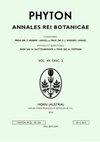Toxic and Antifeedant Effects of Different Pesticidal Plant Extracts against Beet Armyworm (Spodoptera exigua)
IF 0.1
4区 生物学
Q4 PLANT SCIENCES
引用次数: 2
Abstract
The beet armyworm (BAW), Spodoptera exigua (Lepidoptera: Noctuidae) is a highly destructive pest of vegetables and field crops. Management of beet armyworm primarily relies on synthetic pesticides, which is threatening the beneficial community and environment. Most importantly, the BAW developed resistance to synthetic pesticides with making it difficult to manage. Therefore, alternative and environment-friendly pest management tactics are urgently required. The use of pesticidal plant extracts provides an effective way for a sustainable pest management program. To evaluate the use of pesticidal plant extracts against BAW, we selected six plant species (Lantana camara, Aloe vera, Azadirachta indica, Cymbopogon citratus, Nicotiana tabacum, and Ocimum basilicum) for initial screening experiment. Four out of six plant species such as A. indica, N. tabacum, C. citratus and O. basilicum showed promising mortality of more than 50%. Therefore, we selected these four plant extracts for the subsequent experiments. Through contact bioassay, A. indica showed high mortality 66.63%, followed by the N. tabacum 53.33%, at 10% w/v concentration. Similarly, N. tabacum showed the highest mortality rate, 66% at 10% w/v concentration, followed by the A. indica 46% through feeding bioassay. Furthermore, the feeding deterrence assay showed that C. citratus had a high antifeedant index (−50) followed by A. indica (−39), and N. tabacum (−28). In living plant assay, the N. tabacum extract showed a low mean damage score 3.6 on living cotton plant followed by C. citratus 4.5 and A. indica 5.5. Hence, extracts of three plant species provided promising results against the BAW, which can minimize the use of synthetic chemicals, particularly for small landholding farmers. Further studies are also required to evaluate the effects of these plant extract against BAW on cotton plants under field conditions to optimize the further use.不同农药植物提取物对甜菜夜蛾的毒杀和拒食作用
甜菜粘虫(BAW)是一种对蔬菜和大田作物极具破坏性的害虫。甜菜粘虫的防治主要依靠人工合成农药,对有益群落和环境构成威胁。最重要的是,BAW对合成农药产生了抗药性,使其难以管理。因此,迫切需要替代的、环境友好的有害生物治理策略。农药植物提取物的使用为害虫的可持续治理提供了一种有效的方法。为了评价农药植物提取物对BAW的作用,我们选择了6种植物(Lantana camara、芦荟、印楝、Cymbopogon citratus、Nicotiana tabacum和Ocimum basilicum)进行初步筛选实验。在6种植物中,籼稻、烟叶、柑橘和basilicum等4种植物的死亡率均在50%以上。因此,我们选择了这四种植物提取物进行后续实验。接触生物测定结果表明,10% w/v浓度下,籼稻死亡率最高,为66.63%,其次是烟草,死亡率为53.33%。同样,在10% w/v浓度下,烟草的死亡率最高,为66%,其次是籼稻,为46%。此外,取食威慑实验表明,柑橘的拒食指数最高(- 50),其次是印度稻(- 39)和烟草稻(- 28)。在活株试验中,烟草提取物对棉花的平均危害指数最低,为3.6分,其次是柑桔4.5分和籼稻5.5分。因此,三种植物的提取物对BAW有很好的效果,可以最大限度地减少合成化学品的使用,特别是对小土地所有者。还需要进一步研究这些植物提取物在田间条件下对棉花植株的抗BAW效果,以优化其进一步使用。
本文章由计算机程序翻译,如有差异,请以英文原文为准。
求助全文
约1分钟内获得全文
求助全文

 求助内容:
求助内容: 应助结果提醒方式:
应助结果提醒方式:


